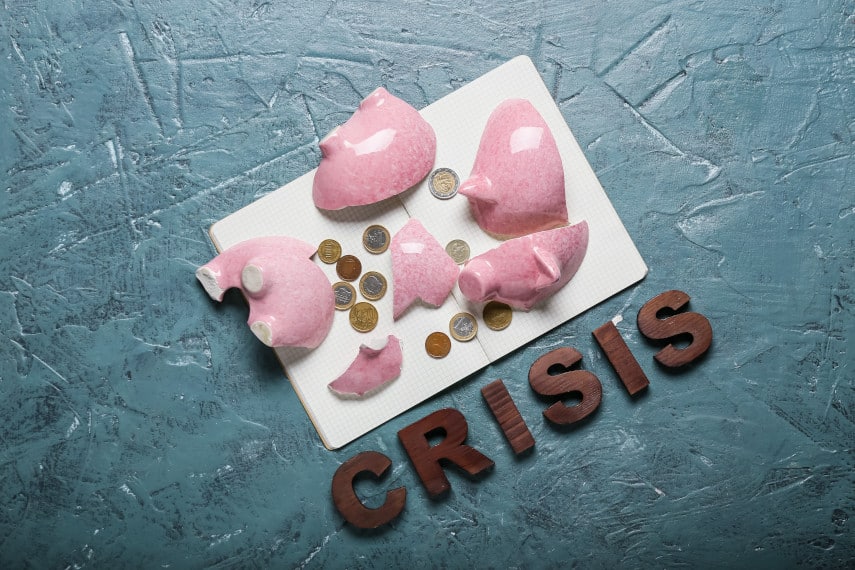6 Indicators of a Potential Recession
It seems that in the media today there are more and more mentions of the dreaded R-word: recession With growing economic uncertainty, the threat of potential recession seems to be growing as...
Economy

While the US banking crisis may seem to be resolved in many people’s eyes, the reality is more likely that it’s just on the back burner. The underlying cause of the crisis hasn’t been resolved, and weakness in the banking industry could end up going from bad to worse.
While many Americans have already taken steps to protect themselves and their assets against the potential for banking system weakness, such as by placing their funds into money market funds or buying gold, many others haven’t. And if the banking system ends up becoming as bad off as it was in 2008, or even worse, many of those who were unprepared could end up suffering financially.
Here are four reasons the US banking crisis could be going from bad to worse.
The three banks that failed this year were the second-, third-, and fourth-largest bank failures in US history. Despite those massive failures, none of these banks were on financial regulators’ radar screens. They weren’t on the list of problem banks that regulators single out for extra oversight.
That’s worrying, because if the banks that aren’t on the government’s watch list are failing, what is happening to the banks that are supposed to be really troubled? Is it only a matter of time before they fail too?
During the 2008 crisis, smaller banks started failing first, with IndyMac and Washington Mutual only failing after several smaller banks (and Bear Stearns) had failed first. With three major banks failing first now, how much worse could the banking crisis get in the future?
After these large bank failures, big banks have only gotten bigger. First Republic, after it failed, was scooped up by JPMorgan Chase, the nation’s biggest bank. And nervous depositors worried about their money held in smaller banks shifted their funds to larger national banks.
As a result, federal regulators are looking at proposing higher capital requirements for these big banks, potentially resulting in those banks having to increase their capital requirements by over 20%. Doing so could result in banks having to cut back on lending, call in loans, or shut down lines of credit. That could impact numerous households and small businesses, which could further move the economy toward recession.
In fact, bank lending standards are already tightening, with more than 40% of banks already showing signs of tightening lending. That isn’t quite as many as tightened during the 2008 crisis and during the dotcom bubble, but it’s getting up there very quickly.
At the very least, this tightening of standards is an indication that recession is in the forecast, if we’re not already in a recession right now. And any actions the federal government takes that could impact bank lending could make the recession even worse.
The stability of the banking system today rests in large part on the belief by depositors that their money held in FDIC-insured banks is safe. Currently up to $250,000 per account is insured by the FDIC.
The problem with FDIC insurance has always been that the amount of FDIC insurance is only a small percentage of the amount of insured deposits, so that in the event of a systemic failure, the Deposit Insurance Fund could be completely wiped out.
From the end of 2022 to the end of the first quarter of 2023, total insured deposits climbed from $10.2 trillion to nearly $10.5 trillion. Yet the Deposit Insurance Fund dropped from $128.2 billion to $116.1 billion.
Think about that. Over $10 trillion in deposits is supposedly insured by only $116 billion in insurance funding.
Then think about the fact that these numbers are from March 31st, after Silicon Valley Bank and Signature Bank failed, but before First Republic Bank failed. Those banks had a total of $550 billion in assets, although much of that was in the form of uninsured deposits.
Still, the federal government made all of those depositors whole, not just the insured depositors. So what will FDIC’s numbers look like when the second quarter figures are published this summer? Will those bank failures end up depleting the Deposit Insurance Fund even further?
Many people have warned that the Deposit Insurance Fund couldn’t possibly backstop the US banking system. And now we have had three bank failures that could have completely wiped out the Fund.
The fear was that once the Fund was unable to pay back depositors, any assistance to failed banks would come in the form of the Federal Reserve printing money out of thin air. Indeed, the $190 billion in credit extensions on the Fed’s balance sheet seems to bear that out.
We’ll have to wait to see what the Deposit Insurance Fund’s fiscal situation looks like after June, but it seems that any future bank failures are going to result in a bailout by the Fed, which doesn’t exactly inspire confidence in the FDIC’s ability to backstop the banking system. And future bailouts that require that kind of monetary creation could lead to higher inflation and put a crimp on the Fed’s ability to engage in monetary policy.
While everything may seem to be doom and gloom for the banking sector, are there any areas of hope in the economy? The labor market appears to be in decent shape for an economy on the verge of recession. And Wall Street doesn’t look to be panicking, although stock markets are always a lagging indicator.
Then there’s gold, which has been in great demand for the past several years and recently pushed close to its all-time highs. The banking crisis encouraged many Americans to take a good hard look at their assets, and many chose to protect their wealth by buying gold.
Gold has served as a safe haven asset and store of wealth for centuries, and has a history of performing well during times of crisis. During the 2008 financial crisis, for instance, gold gained 25 percent at the same time markets lost more than 50 percent. And gold went on to set all-time highs a few years later, nearly tripling in price as markets struggled to regain their footing. Recently gold has once again pushed close to its all-time highs, as fears of a banking crisis have helped spur more gold buying.
If you’re looking to safeguard your hard-earned savings against the negative effects of a banking crisis, recession, or protracted inflation, maybe it’s time to start thinking about gold. You can choose to buy gold through direct cash purchases, or with a gold IRA you can protect your existing tax-advantaged retirement savings with a tax-free rollover.
No matter how you decide to buy gold, it’s essential that you work with trusted partners. Goldco has helped thousands of customers buy gold over the years, and we’ve made over $2 billion in precious metals placements. Give Goldco a call today to learn more about how gold can help you protect your financial future.

